Cloudy Focaccia Bread
Make Cloudy Focaccia Bread with a high-hydration dough for a soft, airy texture. Easy, flavorful, and perfect with endless toppings.
Servings
Prep Time
Cook Time
Ingredients
Total Time
Ingredients
For the dough:
- 800 g all-purpose flour
- 200 g semolina flour (for strength)
- 10 g salt
- 2 tablespoons olive oil (plus extra for drizzling)
- 800 ml water (add gradually)
- 1 packet dry yeast
For the toppings:
- Fresh tomatoes, sliced
- Fresh basil leaves
- Sea salt
- Olive oil for drizzling
- Extra semolina for dusting the tray
Equipment
- Large mixing bowl
- Stand mixer with dough hook
- Measuring cups & spoons
- Large springform pan
- Plastic wrap
- Tea towel
- Oven
- Wire rack
Instructions
Every time we travel to Italy, I can’t resist having at least one fresh, fluffy focaccia “panino.” For me, it’s as essential as the trip itself.
While the original Italian focaccia recipe is already a masterpiece, I’ve found a way to adapt it for our home kitchen. I keep the same irresistible flavor and texture, but make it just a little bit easier to prepare.
This version blends tradition with my personal method, focusing on reducing the oil content. Many recipes use generous amounts of olive oil throughout, but I prefer to be more selective, adding it in key moments for flavor without overloading the dough.
But let’s not linger any longer and see how to make focaccia bread the easy way.
How to Make Focaccia Bread
- Mix the Dough: In a large mixing bowl, combine the all-purpose flour, semolina, salt, yeast and 1 tbsp olive oil.
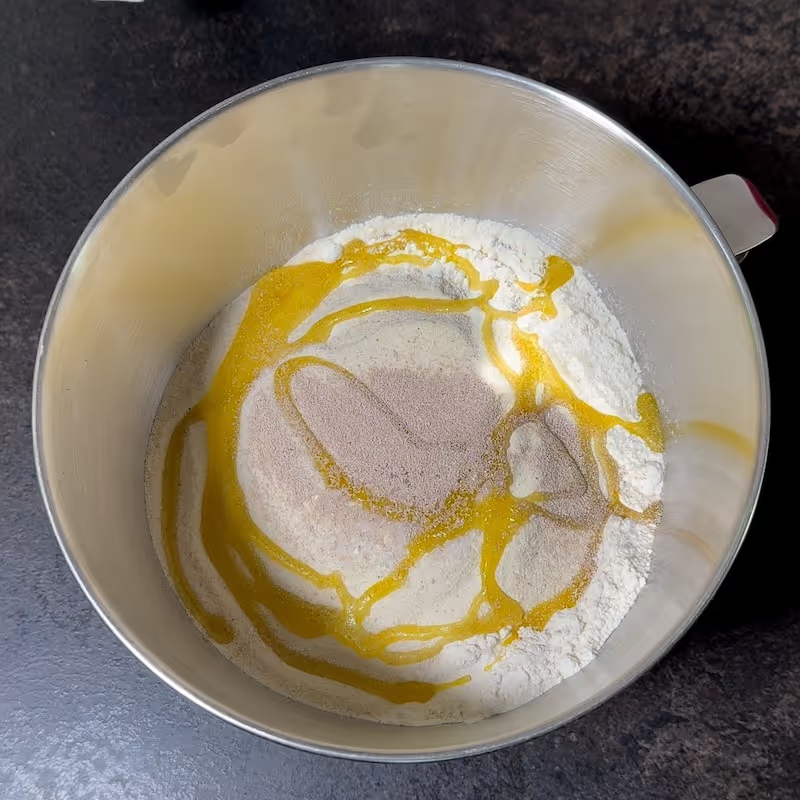
- Pour in the water and start mixing with a dough hook attachment.
- The dough should be wet and sticky — this high hydration is key for achieving the fluffy texture of a no knead focaccia.
- Make sure there are no pockets of dry flour.
- Add the second tbsp of olive oil and finish mixing.
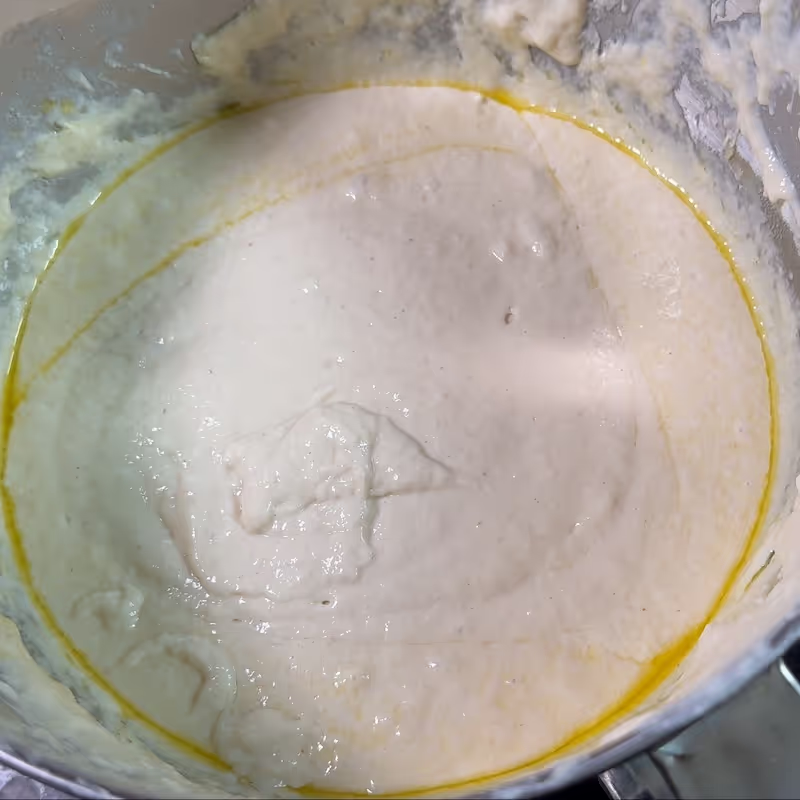
- First Proof: Cover the bowl with plastic wrap and let the dough rise for 3 hours in the oven with just the light turned on.
- Alternatively, use cold water and let it rise overnight at room temperature.
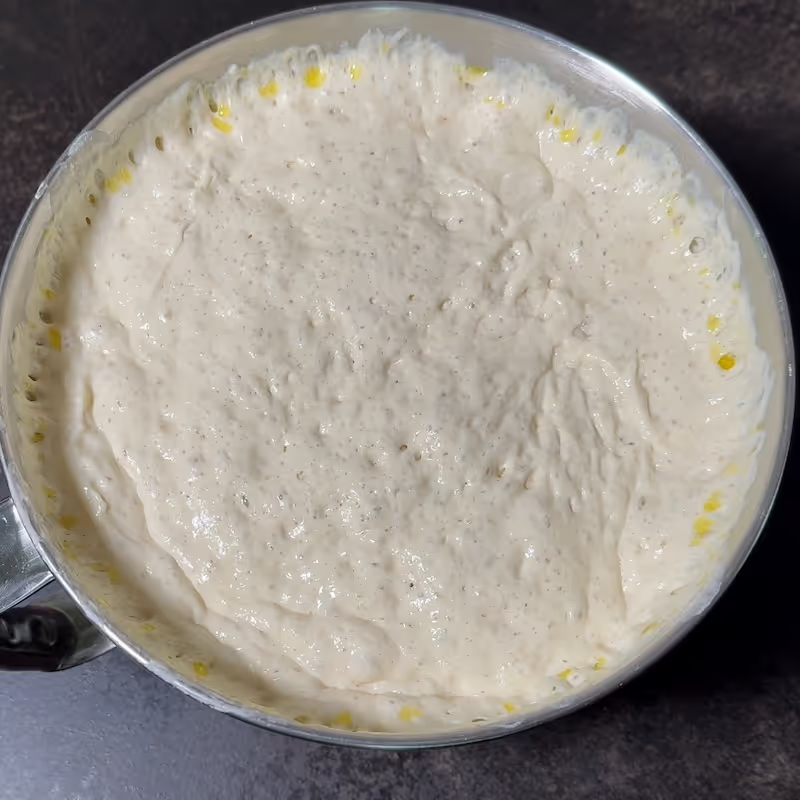
- Prepare the Pan: Dust a large springform pan generously with semolina to prevent sticking.
- Shape the Dough: Gently transfer the dough to the pan and spread it with your fingers until it covers the base.
- Since the dough is very wet, the characteristic dimples of Italian focaccia bread will form naturally. No need to press them in.
- Add the Toppings: Arrange the sliced tomatoes and fresh basil over the surface.
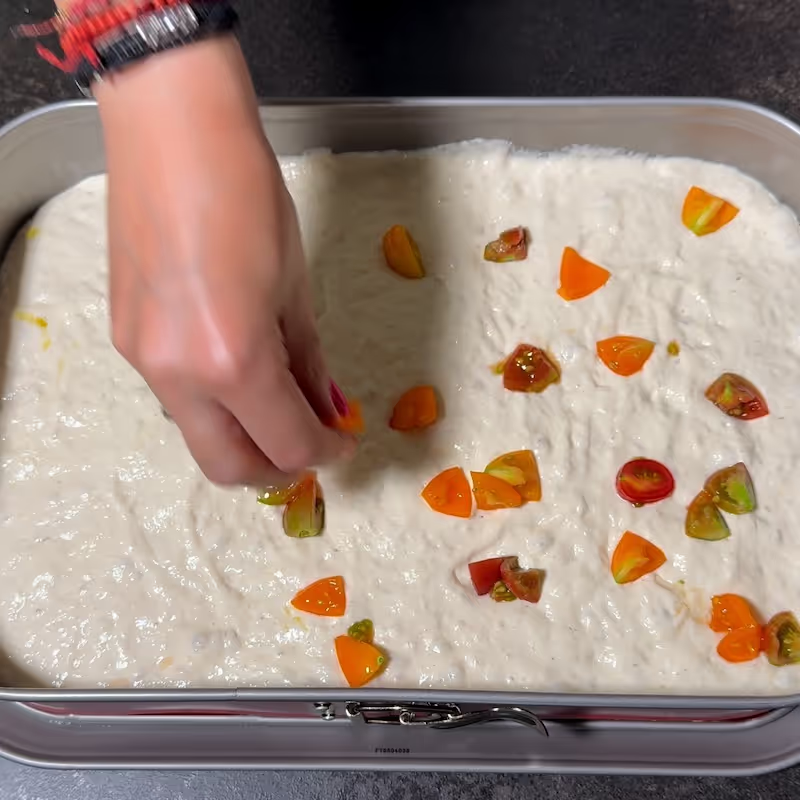
- Sprinkle with sea salt, drizzle with olive oil, and cover the pan with a tea towel. Let it rise for another 45 minutes.
- Bake: Preheat the oven to 220°C (400°F). Cover the focaccia loosely with aluminum foil and bake for 30 minutes. Remove the foil and bake for another 30 minutes until golden.
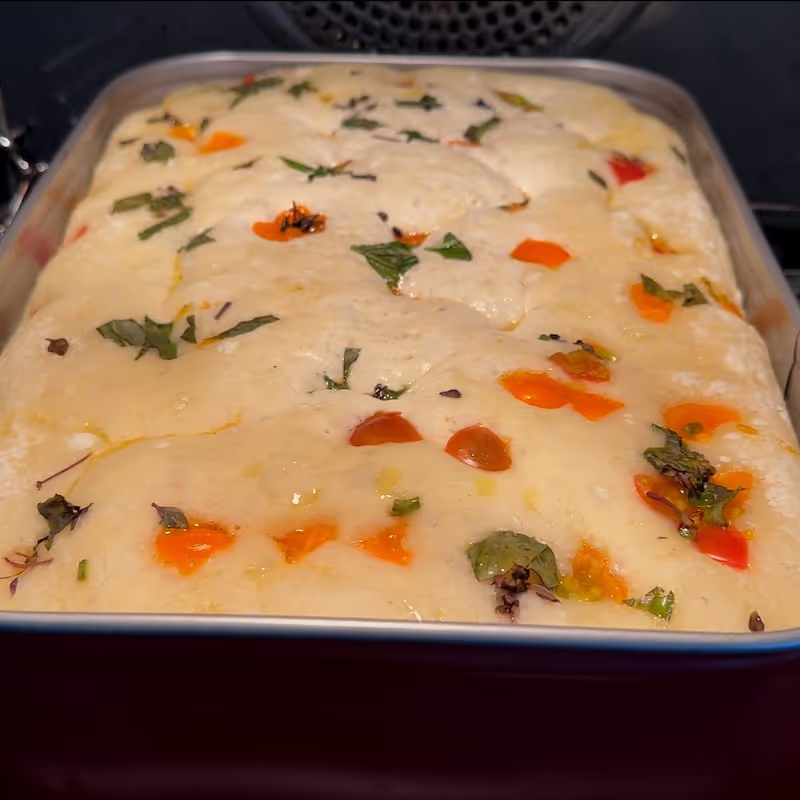
- Finish and Rest: Once baked, drizzle with more olive oil immediately — the bread will absorb it like a sponge.
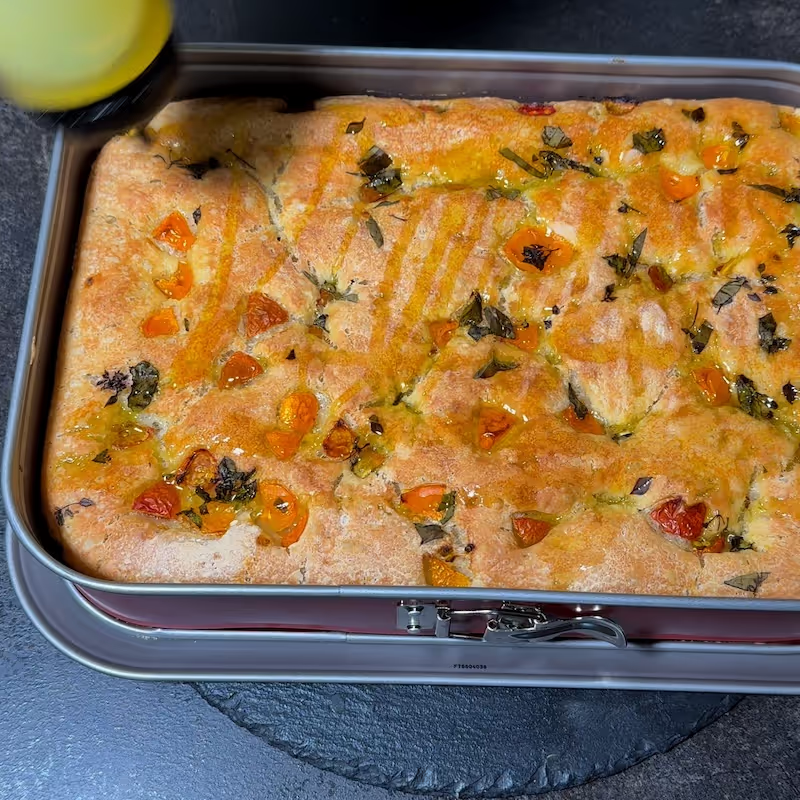
- Remove from the pan, place on a wire rack, and let it rest for at least 30 minutes before slicing.
The Story Behind This Recipe
Influences & History
The focaccia bread recipe dates back to at least the 14th century, originating in the Liguria region of Italy.
Traditionally, it is made with strong, high-gluten flour, plenty of olive oil, and baked in a flat pan, often with a variety of toppings such as rosemary, onions, or olives.
Over centuries, each Italian region has developed its own twist, making focaccia bread a staple across the country.
My Adaptation
One of the biggest differences between my recipe and the classic version is the much higher dough hydration. While traditional focaccia uses a moderately hydrated dough, mine has a wetter consistency. This allows the gluten to develop naturally without much kneading, giving us a bread that’s light, airy, and almost cloud-like in texture.
Combined with the reduced oil content, it makes for the best focaccia bread recipe that’s both indulgent and slightly more wholesome.
Lastly, I skip some of the more complicated steps traditional bakers use, such as multiple layering.
Instead, I opt for a single thick layer that bakes evenly and produces a soft interior with a lightly crisp crust. The result is a bread perfect for tearing apart, dipping in olive oil, or making hearty sandwiches.
Nutrition & Serving
A slice of this bread contains fewer focaccia calories than traditional oil-rich versions, while still providing the classic flavor. The combination of carbohydrates from the flour and healthy fats from the olive oil makes it both energizing and satisfying. For a balanced meal, pair it with protein-rich fillings or serve alongside soups and salads.
FAQ
Q: What are the best focaccia toppings?
A: Popular options include cherry tomatoes, rosemary, caramelized onions, olives, garlic, or cheese. This Italian focaccia recipe also works beautifully with sweet toppings like grapes or figs.
Q: How many focaccia calories are in one slice?
A: On average, a slice from this recipe has about 180–220 calories, depending on the amount of olive oil and toppings used.
Q: Can I make this as a no knead focaccia?
A: Yes! This is already a no knead focaccia method, relying on high hydration and long fermentation instead of heavy kneading.
Q: What’s the difference between focaccia bread and pizza dough?
A: While similar, focaccia bread is thicker, fluffier, and has more olive oil than pizza dough, which is usually thinner and less hydrated.
Q: Is this the best focaccia bread recipe for beginners?
A: Definitely. This is an easy focaccia recipe that’s forgiving, requires minimal handling, and still delivers bakery-quality results.
Conclusion
I hope you’ll try this lighter yet flavorful twist on the best focaccia bread recipe and enjoy the same joy we feel every time we bake it. When you do, tag us so we can see your creations!
The full step-by-step video is available on our YouTube channel — so check it out, and don’t forget to like and subscribe for more recipes like this one.
Nutrition Facts / Serving
- Calories 348 kcal
- Total Fat 5.42 g
- Cholesterol 0 mg
- Sodium 487 mg
- Potassium 157 mg
- Total Carbohydrate 63.72 g
- Sugars 0.70 g
- Protein 9.19 g


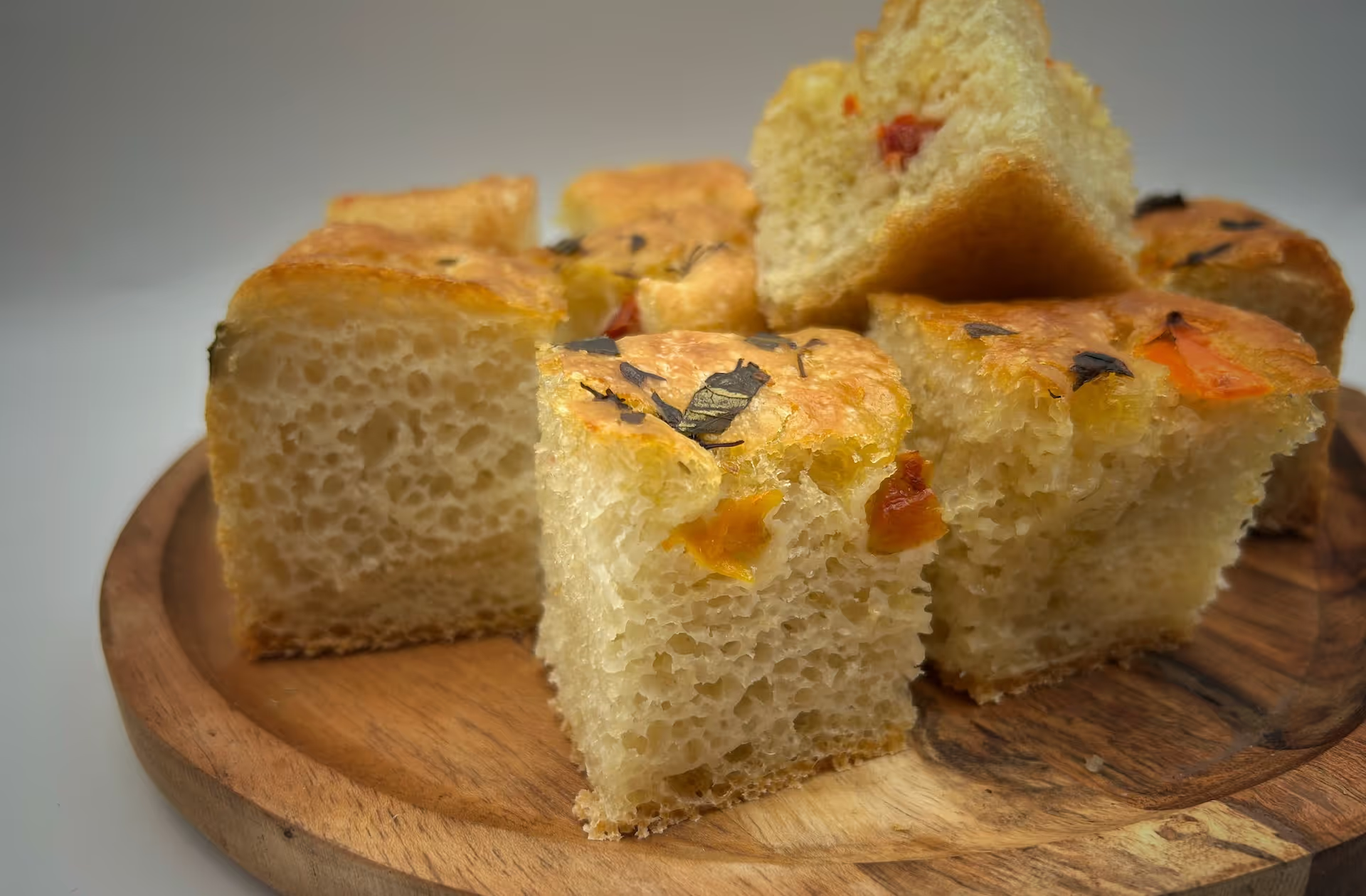

.svg)







